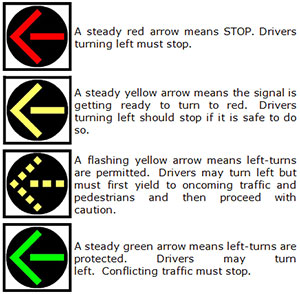WTF? Oh, it’s a FYA!

“What the heck is that?!”
That seems to be a common reaction of local motorists as they first encounter one of the flashing yellow arrow (FYA) traffic signals that have popped-up at San Antonio intersections over the past year or so. What began as an experiment in late 2008 at a couple dozen intersections along Wurzbach Rd. and San Pedro Ave. has now spread to about 40 or so intersections across the city and will now become a standard, not just here in San Antonio, but nationally as mandated by the federal Manual on Uniform Traffic Control Devices (MUTCD). As often happens in these cases, there has been some second-guessing amongst the general public as to the necessity of this newfangled signal, but understanding the research that went into it and why it’s beneficial generally allays those knee-jerk criticisms.
The purpose of the FYA signals is to indicate that left-turning vehicles must yield to oncoming traffic. Previously, the solid green circular signal (“green ball”) was used, typically in a five-section cluster signal arrangement known colloquially to traffic engineers as the “dog house” display. However, studies around the nation showed that this signal was often misconstrued by motorists to mean that they had the right-of-way. This was especially true when it was used as part of so-called “Dallas phasing”, which extends the permissive left-turn time at an intersection by de-coupling that left turn movement from the adjacent through movement. In other words, the left turn lane could have a green ball while the adjacent through-traffic lanes could have a red light. A few Dallas-phased signals were installed in San Antonio in the Medical Center area, and I can tell you from experience that many drivers are quite confused by them. However, Dallas phasing provides a big benefit in the form of more efficient intersection flow because left turns can be made at any time during the phase (when traffic is clear, of course) instead of only when adjacent through traffic also has a green, thus allowing more vehicles to get through during each cycle and reducing delays for left-turning drivers. Dallas phasing also solves the problem of the “yellow trap” that occurs when a circular yellow light is displayed to traffic waiting to make a permissive left turn while, at the same time, opposing through traffic still has a green light. This usually causes those left-turning motorists to presume oncoming traffic is about to stop and that it is safe to complete their left turn when in fact it is not.
So, to capture the benefits of Dallas phasing without the inherent safety issue involved with using a green ball signal for permissive lefts, engineers across the country tried a variety of other displays and several studies were done. The one display that had the greatest inherent understanding was the FYA. More importantly, the FYA had the lowest “fail-critical” rate, which means that drivers were less likely to do the “wrong” thing if they didn’t understand what the signal meant. In other words, drivers that see a FYA and don’t understand it are more likely to yield whereas drivers who see a green ball are more likely to proceed. The reason for this is easy to explain: people inherently understand a flashing yellow light to mean “caution” while we instinctively interpret a green light to mean “go”. It’s also worth noting that the FYA indication has been used successfully in parts of Europe for many years.
As a result of these outcomes, the Federal Highway Administration has designated the FYA as the standard signal display for protected/permissive left turn signals in the latest release of the MUTCD, which was promulgated last December. Additionally, no signal displays with a solid green ball signal can be placed to the left of the lane line between the left turn lane and the adjacent through traffic lane. In other words, left turn lanes cannot have a dedicated signal that has a green ball display. Of course, it will take quite some time to retrofit existing signals to meet the new standards, and the MUTCD has set no target date for full replacement. However, all new signals and refurbishments of existing signals will have to be compliant going forward.

Additional reading: